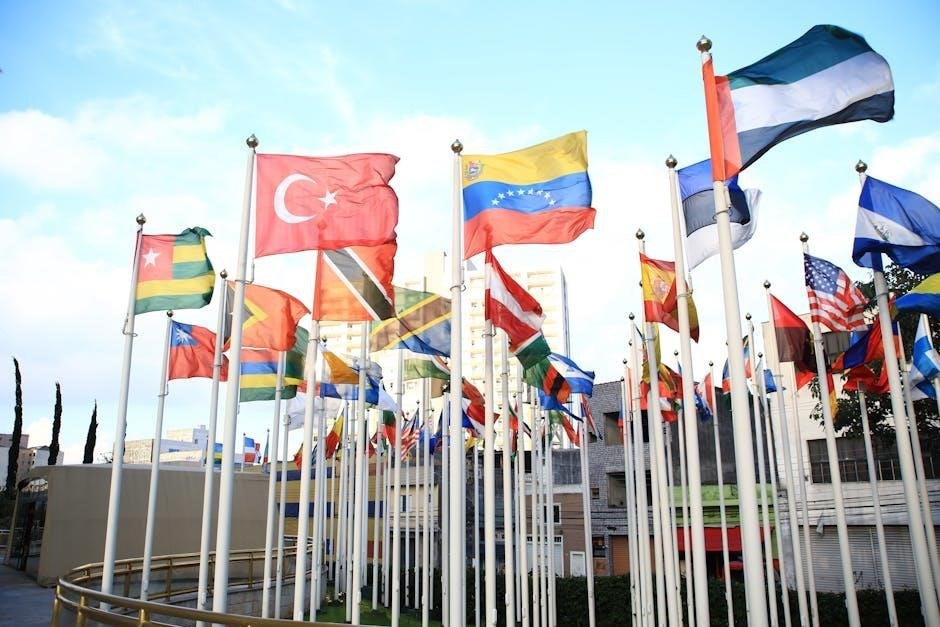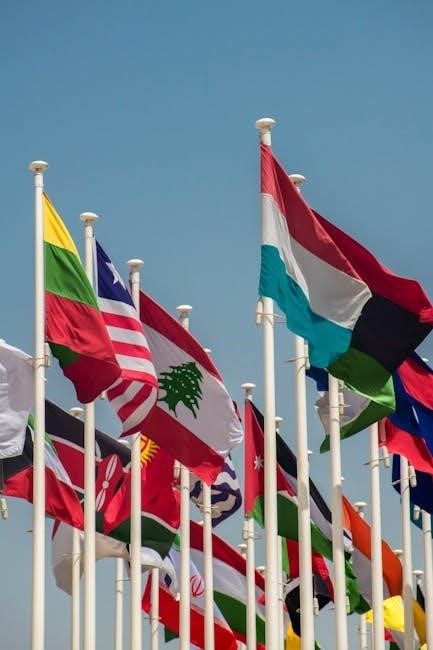The Flags of the World PDF is a comprehensive guide featuring over 200 national flags, historical backgrounds, and design elements, offering an educational journey through global symbolism and cultural heritage․
1․1 Overview of the Flags of the World PDF
The Flags of the World PDF is a meticulously organized document that showcases national and international flags in high-quality formats․ It includes over 200 flags, covering UN member states, non-member countries, and other recognized territories․ The guide is alphabetically arranged, making it easy to navigate and locate specific flags․ Each flag is available in both SVG and PNG formats, ensuring clarity and versatility for various uses․ The PDF also provides detailed descriptions, historical context, and design insights, offering a deeper understanding of each flag’s significance․ This resource is ideal for educational purposes, research, or casual exploration, catering to anyone interested in the rich symbolism of global flags․
1․2 Importance of Flags as National Symbols
Flags are vibrant representations of national identity, embodying a country’s history, values, and cultural heritage․ They serve as unifying symbols, fostering patriotism and pride among citizens․ Flags are also crucial for international recognition, distinguishing nations on the global stage․ Their designs often reflect historical events, significant figures, or natural landmarks, making them invaluable for cultural education․ Beyond their aesthetic appeal, flags play a role in diplomacy, sports, and political movements, symbolizing sovereignty and unity․ They are a universal language, transcending verbal communication to convey a nation’s spirit and aspirations․ Understanding flags deepens appreciation for global diversity and the stories behind each nation’s identity․
1․3 Purpose of the Flags of the World PDF Guide
The Flags of the World PDF Guide serves as a comprehensive resource for exploring national, historical, and cultural flags․ Its purpose is to educate users about the significance of flags, their designs, and the stories they represent․ The guide includes detailed descriptions, high-quality images, and an organized index for easy navigation․ It aims to cater to educators, students, and enthusiasts, providing insights into the symbolism and history behind each flag․ By offering updated information and a user-friendly format, the guide facilitates a deeper understanding of global diversity and cultural heritage․ It is an essential tool for anyone interested in flags as symbols of identity, unity, and national pride․

History of Flags
The Flags of the World PDF traces the evolution of flags from ancient symbols to modern national emblems, highlighting their historical significance and cultural heritage globally․
2․1 Evolution of Flag Design
The evolution of flag design reflects cultural, political, and technological advancements․ Early flags were simple, often featuring basic symbols or patterns, used primarily for military identification․ Over time, designs became more intricate, incorporating heraldry and national emblems․ The rise of nationalism in the 18th and 19th centuries led to standardized national flags, symbolizing sovereignty and identity․ Modern flags often blend traditional elements with contemporary design principles, emphasizing simplicity and universal recognition․ Advances in materials and printing have enabled vibrant, durable designs․ The Flags of the World PDF showcases this journey, offering high-quality images and detailed descriptions of historical and modern flags, making it an invaluable resource for exploring the dynamic history of flag design․
2․2 Historical Significance of Flags
Flags have long served as vital symbols of identity, sovereignty, and unity, tracing their origins to ancient civilizations․ Early uses included military identification and religious representation, with designs often reflecting cultural values․ The Flags of the World PDF highlights how flags evolved into powerful national symbols, particularly during the Age of Sail, when they identified ships and nations․ The rise of nationalism in the 18th and 19th centuries solidified flags as emblems of statehood․ Historically, flags have also played roles in revolutions, political movements, and unification efforts, such as the American and French Revolutions․ Today, they remain central to national pride and international recognition, documenting the rich tapestry of global history and cultural identity through their designs and meanings․
2․3 Key Milestones in Flag Development
Flag development has marked significant historical turning points, beginning with ancient civilizations like Egypt and China, where early flags symbolized divine authority and empire identity․ Japan’s samurai era introduced “nobori” banners for battlefield identification․ The Age of Sail brought maritime flags, crucial for ship recognition․ Denmark’s Dannebrog, the world’s oldest national flag, emerged in the 14th century․ The 18th and 19th centuries saw nationalism rise, leading to standardized national flags․ The 20th century witnessed flags as symbols of political movements and decolonization, with new nations adopting unique designs post-independence․ The United Nations further cemented flags as symbols of international unity and sovereignty, reflecting global interconnectedness and cultural identity․
How to Use the Flags of the World PDF
The Flags of the World PDF is easy to navigate with an index of flags by country and a search function for quick access to any flag․
3․1 Navigating the PDF Guide
Navigating the Flags of the World PDF is straightforward, with a clear table of contents and bookmarks for easy access to specific sections․ Users can quickly locate flags by country or region using the index, which is alphabetically organized․ The PDF also features a search function, allowing users to type in a country’s name and instantly find its flag․ This functionality ensures efficient browsing and minimizes time spent searching for individual flags․ Additionally, the guide includes high-quality images in SVG and PNG formats, ensuring clarity and versatility for both digital and printed use․ These features make the PDF user-friendly and accessible for everyone․
3․2 Index of Flags by Country
The Flags of the World PDF includes a detailed index of flags organized alphabetically by country, making it easy to locate specific flags quickly․ This index covers over 200 national flags, including those of UN member states and non-member countries like Taiwan and Kosovo․ Each entry is accompanied by a high-quality image in SVG or PNG format, ensuring clarity and vibrant colors․ The index also includes historical flags, providing a broader perspective on flag evolution․ Users can instantly access flags from any region, making the guide a valuable resource for researchers, educators, and enthusiasts․ This comprehensive index ensures that every internationally recognized country is represented, offering a complete and user-friendly reference․
3․3 Search Functionality in the PDF
The Flags of the World PDF features an advanced search functionality, allowing users to quickly find specific flags by country name, keyword, or region․ This tool streamlines navigation, enabling seamless access to over 200 national and historical flags․ Users can search for flags by typing in the country’s name or related terms, with results appearing instantly․ The PDF also supports filtering options, such as searching by continent or flag design elements․ This feature is particularly useful for researchers and educators who need rapid access to information․ The search function enhances the overall user experience, making the guide a practical and efficient resource for exploring the world of flags․
Categories of Flags
The Flags of the World PDF organizes flags into categories such as national, international, historical, and regional, providing a structured approach to exploring global vexillology and its diversity․
4․1 National Flags
National flags represent the identity and sovereignty of individual countries․ The Flags of the World PDF includes flags from all 193 UN member states, plus additional recognized nations like Taiwan and Kosovo․ Each flag is presented in high-quality formats, such as SVG and PNG, ensuring clarity and detail․ The guide provides historical context, design symbolism, and cultural significance for each national flag․ Users can explore flags alphabetically, making it easy to find specific countries․ The PDF also highlights unique design elements, such as colors, symbols, and patterns, that distinguish one nation’s flag from another․ This section serves as a valuable resource for understanding the diverse vexillology of the world, offering insights into the stories and histories behind each flag․

4․2 International Organization Flags
The Flags of the World PDF features an extensive collection of international organization flags, representing global unity and cooperation․ These include flags from prominent entities like the United Nations, European Union, and African Union․ Each flag is depicted in high-resolution formats such as SVG and PNG, ensuring vivid colors and intricate details․ The guide provides descriptions of the symbolism behind these flags, highlighting their role in fostering international collaboration․ Users can explore the diverse designs, from the EU’s circle of stars to the UN’s world map emblem․ This section offers a unique perspective on how international organizations visually represent their missions and values, making it a valuable resource for understanding global governance and diplomacy․
4․3 Historical Flags
The Flags of the World PDF also includes a fascinating collection of historical flags, offering insights into the evolution of national identities and political changes over time․ These flags represent former nations, empires, and significant historical events, such as the Roman Empire, the Soviet Union, and the Confederate States of America․ Each flag is accompanied by detailed descriptions, highlighting its significance and the era it represents․ The PDF features over 300 historical flags, providing a visual and educational journey through time․ This section is invaluable for historians, researchers, and enthusiasts seeking to understand the cultural and political shifts that shaped the world; The high-quality images and informative context make it a unique resource for exploring the past․
Design Elements of Flags
The Flags of the World PDF explores the symbolism behind flag designs, including common symbols like stars, stripes, and colors, which often reflect a nation’s history and values․
5․1 Common Symbols and Their Meanings
Flags often feature universal symbols like stars, stripes, and eagles, which carry deep cultural and historical significance․ Stars symbolize unity, hope, or divine guidance, while stripes may represent liberation or regional divisions․ Eagles and other animals frequently denote strength and sovereignty․ Colors also play a crucial role, with red often signifying bravery, green representing nature or faith, and blue symbolizing peace or eternity․ These symbols are carefully chosen to reflect a nation’s values, history, or geography․ By analyzing these elements, one can gain insight into a country’s identity and heritage․ The Flags of the World PDF provides detailed explanations of these symbols, helping readers decode the stories behind each flag’s design․
5․2 Color Significance in Flag Design
Colors in flag design carry profound meaning, often reflecting a nation’s history, culture, or natural environment․ Red typically symbolizes bravery, revolution, or bloodshed, while green represents faith, fertility, or Islamic heritage․ Blue often denotes peace, freedom, or the sky, and yellow frequently signifies sunshine, wealth, or optimism․ Black and white are used to convey neutrality, purity, or mourning․ The choice of colors is intentional, aiming to evoke specific emotions and connect with the nation’s identity․ For instance, the green in Pakistan’s flag represents its lush landscapes and Islamic roots, while the red in South Africa’s flag symbolizes the struggle for freedom․ These chromatic elements are meticulously selected to tell a story, as detailed in the Flags of the World PDF․
5․3 Typography and Layout
Typography and layout in flag design are crucial elements that enhance recognition and identity․ Most flags avoid complex text, focusing instead on simple, universally recognizable symbols․ The layout is often balanced and symmetrical, ensuring clarity and visual appeal․ Flags like the United States’ Stars and Stripes use stripes and stars to convey national identity, while Japan’s flag features a centered red circle for simplicity․ The Flags of the World PDF highlights how these design principles create distinctive and meaningful national emblems, ensuring each flag is instantly identifiable․ The careful arrangement of elements ensures that flags are not only aesthetically pleasing but also rich in symbolic meaning, reflecting the nation’s heritage and values․

Regional Flags

The Flags of the World PDF categorizes flags by region, showcasing diverse designs and cultural significance․ Explore the unique symbols and histories of flags from Asia, Europe, Africa, the Americas, and Oceania․
6․1 Flags of Asia
Discover the vibrant flags of Asia, each representing unique cultural and historical identities․ The Flags of the World PDF showcases the diversity of Asian nations, from the Rising Sun of Japan to the Red Star of China․ Explore the intricate designs of India’s tricolor with its Ashoka Chakra and South Korea’s Taegukgi symbolizing balance and harmony․ Learn about the significance of colors and emblems, such as the dragon in Bhutan’s flag or the crescent moon in Pakistan’s, which reflect national values and mythologies․ This section highlights the rich tapestry of Asian flags, offering insights into their historical backgrounds and design elements that symbolize the continent’s cultural heritage․
6․2 Flags of Europe

Europe’s flags are a testament to the continent’s rich history and cultural diversity․ The Flags of the World PDF features iconic designs like France’s tricolor, Germany’s black-red-gold, and the UK’s Union Jack․ Many European flags incorporate crosses, such as Denmark’s Dannebrog and Switzerland’s white cross, while others feature coats of arms or symbolic imagery․ Colors often carry deep meaning, as seen in Spain’s red and yellow, representing bravery and generosity․ The European Union flag, with its circle of stars, symbolizes unity among member nations․ Each flag tells a unique story, reflecting the region’s complex history, national pride, and shared values, making this section a fascinating exploration of European identity and heritage․
6․3 Flags of Africa
Africa’s flags showcase the continent’s vibrant diversity and rich cultural heritage․ The Flags of the World PDF highlights the unique designs of over 50 African nations, each telling a story of independence and identity․ Many flags feature the Pan-African colors—red, gold, and green—symbolizing unity, the struggle for liberation, and the continent’s natural wealth․ Countries like South Africa and Ghana have iconic designs that blend historical and modern elements․ Others, such as Nigeria and Kenya, incorporate symbols like eagles and lions, representing strength and resilience․ The use of bold colors and distinctive patterns reflects Africa’s artistic traditions and its people’s pride․ This section is a visual and educational journey through the diverse identities of Africa’s nations․

6․4 Flags of the Americas
The Flags of the World PDF showcases the diverse flags of the Americas, highlighting the unique cultural and historical identities of nations across North, Central, and South America, as well as the Caribbean․ From the iconic Stars and Stripes of the United States to the vibrant colors of Brazil, each flag tells a story of independence and heritage․ Many designs reflect indigenous influences, colonial legacies, and natural landscapes․ For instance, Canada’s maple leaf and Mexico’s eagle symbolize national pride and historical roots․ The PDF guide provides detailed descriptions, allowing users to explore the symbolism and significance of over 40 flags in the region, offering a fascinating glimpse into the Americas’ rich tapestry of cultures and histories․
6․5 Flags of Oceania
Oceania’s flags are a vibrant reflection of the region’s diverse cultures and histories․ The Flags of the World PDF highlights the unique designs of nations like Australia, New Zealand, and Papua New Guinea, showcasing their distinct identities․ Australia’s flag features the Commonwealth Star and the Union Jack, while New Zealand’s incorporates the Southern Cross constellation․ Pacific Island nations, such as Fiji and Samoa, display indigenous patterns and symbols that reflect their rich traditions․ The flags of Oceania often blend colonial legacies with local motifs, creating a visually striking and historically significant collection․ This section of the PDF guide offers insights into the stories behind these designs, making it a fascinating resource for exploring the region’s cultural heritage․
Flags in Culture and Society
Flags are cultural icons representing national identity, unity, and history․ They appear in sports, political movements, and daily life, symbolizing pride and heritage at global events․
7․1 Flags as Cultural Icons
Flags serve as powerful cultural icons, symbolizing national identity, unity, and heritage․ They are often displayed during global events, sports, and celebrations, evoking pride and patriotism․
As unique symbols, flags tell stories about a nation’s history, values, and aspirations․ They are used in tourism, education, and political movements, making them integral to cultural expression․
Their designs, colors, and emblems carry deep meanings, reflecting a country’s journey and beliefs․ Flags also unite people across borders, representing shared values and solidarity in international contexts․
In the Flags of the World PDF, these cultural icons are showcased with detailed descriptions, offering insights into their significance and role in shaping national identity and global connections․
7․2 Flags in Sports and Events
Flags play a significant role in sports and global events, fostering national pride and unity․ During international competitions like the Olympics or FIFA World Cup, flags are prominently displayed to represent participating nations․
They are waved by fans to show support for their teams, creating a vibrant and patriotic atmosphere․ Flags also serve as symbols of identity during cultural festivals and international summits․
In the Flags of the World PDF, the use of flags in sports and events is highlighted, showcasing their importance in uniting people and celebrating diversity․ High-quality images and detailed descriptions provide insights into their role in global celebrations and competitions․
7․3 Flags in Political Movements
Flags are powerful symbols in political movements, representing ideologies, unity, and resistance․ They are often used to rally support, express dissent, or signify independence․
During protests and rallies, flags become visual statements of identity and purpose, fostering solidarity among participants․ Historical and contemporary movements, such as independence struggles or social justice campaigns, frequently adopt distinct flag designs․
The Flags of the World PDF highlights how flags have been central to political causes, serving as tools for communication and inspiration․ Their designs often incorporate meaningful colors and symbols, reflecting the values and goals of the movement they represent․

Technical Aspects of the PDF
The Flags of the World PDF features high-quality SVG and PNG formats, ensuring sharp visuals and fast loading․ It is compatible with all devices and includes easy download options․
8․1 SVG and PNG Formats
The Flags of the World PDF utilizes SVG and PNG formats to ensure high-quality visuals․ SVG (Scalable Vector Graphics) allows flags to be scaled without losing resolution, making them crisp on any device․ PNG (Portable Network Graphics) provides rich colors and transparency, ideal for detailed displays; These formats are optimized for fast loading and compatibility across devices․ Users can download flags in PNG for full-resolution viewing or rely on SVG for scalable, lightweight usage․ Both formats ensure vibrant colors and clarity, catering to different needs such as web use or printing․ The inclusion of these formats enhances the PDF’s versatility and user experience, ensuring accessibility and visual fidelity for all users․
8․2 Downloading and Viewing Options
The Flags of the World PDF offers convenient downloading and viewing options․ Users can easily download the PDF and access high-resolution flag images in both SVG and PNG formats․ The guide is optimized for viewing on various devices, including desktops, tablets, and smartphones․ A user-friendly interface allows seamless navigation, with features like bookmarks and a search function to quickly locate specific flags․ The PDF is designed to be lightweight for fast downloads while maintaining crisp visuals․ Whether for educational purposes, research, or personal interest, the Flags of the World PDF provides a versatile and accessible way to explore global flags, ensuring a seamless viewing experience across all platforms․
8․4 Compatibility Across Devices
The Flags of the World PDF is designed to ensure compatibility across a wide range of devices․ Whether viewed on a desktop, tablet, or smartphone, the guide maintains its clarity and visual appeal․ The lightweight design ensures fast loading times, while the responsive layout adapts seamlessly to different screen sizes․ High-quality images in SVG and PNG formats are optimized for various devices, preserving their vibrant colors and details․ This cross-platform compatibility makes it easy for users to access and explore the guide anywhere, anytime, providing a consistent and immersive experience regardless of the device used․

Flags of the World PDF Features
The guide offers high-quality images, detailed descriptions, and updated information, ensuring a comprehensive and visually engaging experience for users exploring flags from around the globe․
9․1 High-Quality Images
The Flags of the World PDF features high-quality images in both SVG and PNG formats, ensuring sharp details and vibrant colors․ The SVG format allows for scalable vector graphics, maintaining clarity at any resolution, while PNGs provide rich, full-color representations․ These formats are optimized for digital viewing and printing, making the guide versatile for various uses․ The images are carefully designed to accurately represent each flag’s intricate details, from subtle patterns to precise color schemes․ This attention to detail ensures that users can fully appreciate the artistic and symbolic elements of each flag․ Whether for educational purposes, design inspiration, or personal reference, the high-quality visuals enhance the overall experience of exploring global flags․
9․2 Detailed Descriptions
The Flags of the World PDF provides detailed descriptions for each flag, offering insights into their historical backgrounds, symbolic meanings, and unique design elements․ Each entry includes information about the flag’s adoption date, color significance, and cultural relevance․ The guide also highlights the evolution of flag designs over time, noting any notable changes and their historical context․ Additionally, the descriptions cover international and historical flags, offering a comprehensive understanding of their roles and representations․ This feature makes the guide invaluable for researchers, students, and enthusiasts, providing a deeper appreciation of the stories behind each flag․ The detailed descriptions enhance the educational value of the PDF, making it a rich resource for exploring global vexillology․
9․3 Updated Information
The Flags of the World PDF is regularly updated to ensure accuracy and relevance, reflecting the latest changes in national and international flags․ It includes recent additions of newly recognized countries, such as Kosovo and Palestine, as well as updated designs for existing flags․ The guide also incorporates historical flags that have been reintroduced or modified, providing a dynamic perspective on vexillological changes․ With frequent updates, the PDF remains a reliable source for enthusiasts and researchers, ensuring access to the most current information․ This feature underscores its commitment to preserving the evolving nature of flags as symbols of identity and sovereignty․ The updated information makes the guide a go-to resource for staying informed about global flag developments․
The Flags of the World PDF is an invaluable resource for exploring global vexillology, offering insights into cultural heritage and national identity through its comprehensive and visually rich content․
10․1 Final Thoughts on the Flags of the World PDF
The Flags of the World PDF serves as a valuable resource for anyone interested in vexillology, offering a detailed and visually rich exploration of global flags․ Its comprehensive coverage, including national, historical, and regional flags, provides a deep understanding of cultural and political symbolism․ High-quality images and updated information ensure accuracy and accessibility․ This guide not only educates but also inspires curiosity about the diverse identities and histories represented by flags worldwide․ Whether for academic research or personal interest, the PDF is an essential tool for exploring the fascinating world of flags and their significance in shaping national and international identity․
10․2 Encouragement to Explore Flags

Exploring flags is a rewarding journey that offers insights into cultures, histories, and identities worldwide․ Each flag is a unique symbol, telling stories of nations, their values, and their journeys․ By engaging with the Flags of the World PDF, readers can gain a deeper appreciation for the diversity and complexity of global cultures․ Whether for educational purposes or personal curiosity, this guide invites everyone to discover the fascinating world of vexillology․ Flags are not just pieces of fabric; they are windows into the soul of nations, inspiring curiosity and understanding․ Embark on this visual and historical adventure to uncover the stories behind the symbols that unite and distinguish us․
